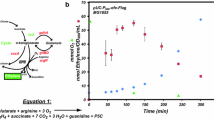Abstract
Growth of Escherichia coli strain B SPAO on a medium containing glucose, NH4Cl and methionine resulted in production of ethylene into the culture headspace. When methionine was excluded from the medium there was little formation of ethylene. Ethylene formation in methionine-containing medium occurred for a brief period at the end of exponential growth. Ethylene formation was stimulated by increasing the medium concentration of Fe3+ when it was chelated to EDTA. Lowering the medium phosphate concentration also appeared to stimulate ethylene formation. Ethylene formation was inhibited in cultures where NH4Cl remained in the stationary phase. Synthesis of the ethylene-forming enzyme system was determined by harvesting bacteria at various stages of growth and assaying the capacity of the bacteria to form ethylene from methionine. Ethylene forming capacity was greatest in cultures harvested immediately before and during the period of optimal ethylene formation. It is concluded that ethylene production by E. coli exhibits the typical properties of secondary metabolism.
Similar content being viewed by others
Abbreviations
- HMBA:
-
2-Hydroxy-4-methylthiobutyric acid (methionine hydroxy analogue)
- KMBA:
-
2-keto-4-methylthiobutyric acid
- MOPS:
-
3-[N-morpholino] propanesulphonic acid
References
Adams DO, Yang SF (1981) Ethylene the gaseous plant hormone: mechanisms and regulation of biosynthesis. Trends Biochem Sci 4:161–164
Billington DC, Golding BT, Primrose SB (1979) Biosynthesis of ethylene from methionine. Isolation of the putative intermediate 4-methylthio-2-oxobutanoate from culture fluids of bacteria and fungi. Biochem J 182:827–836
Brown CM, Dilworth MJ (1975) Ammonia assimilation by Rhizobium cultures and bacteroids. J Gen Microbiol 95:159–165
Bu'lock JD (1961) Intermediary metabolism and antibiotic synthesis. Adv Microbiol 3:293–342
Castric PA, Ebert RF, Castric KF (1979) The relationship between growth phase and cyanogenesis in Pseudomonas aeruginosa. Curr Microbiol 2:287–292
Demain AL, Kennel YM, Aharonowitz Y (1979) Carbon catabolite repression of secondary metabolism. Symp Soc Gen Microbiol 29:163–183
Fawcett JK, Scott JE (1960) A rapid and precise method for the determination of urea. J Clin Pathol 13:156–159
Forsythe WE (1964) Smithsonian physical tables, 9th edn. Smithsonian Institute: Washington DC, p 360
Jones SS, Long FA (1952) Complex ions from iron and ethylenediamine-tetraacetate: general properties and radioactive exchange. J Phys Chem 56:25–33
Niven DF, Collins PA, Knowles CJ (1977) Adenylate energy charge during batch culture of Beneckea natriegens. J Gen Microbiol 98:95–108
Primrose SB (1976a) Formation of ethylene by Escherichia coli. J Gen Microbiol 95:159–165
Primrose SB (1976b) Ethylene-forming bacteria from soil and water. J Gen Microbiol 97:343–346
Primrose SB (1977) Evaluation of the role of methional, 2-keto-4-methylthiobutyric acid and peroxidase in ethylene formation by Escherichia coli. J Gen Microbiol 98:519–528
Primrose SB (1979) Ethylene and agriculture: the role of the microbe. J Appl Bacteriol 46:1–25
Primrose SB, Dilworth MJ (1976) Ethylene production by bacteria. J Gen Microbiol 93:177–18
Rose AH (1979) Production and industrial importance of secondary products of metabolism. In: Rose AH (ed) Economic microbiology, vol 3. Academic Press, London New York, pp. 1–33
Umbarger HE, Magasanik B (1952) Isoleucine and valine metabolism in Escherichia coli. III. A method for the quantitative determination of α-keto acid analogs of isoleucine and valine. J Am Chem Soc 74:4253–4255
Weinberg ED (1977) Mineral element control of microbial metabolism. In: Weinberg ED (ed) Microorganisms and minerals. Marcel Dekker, New York, pp. 289–315
Weinberg ED (1978) Secondary metabolism: regulation by phosphate and trace elements. Folia Microbiol 23:496–504
Author information
Authors and Affiliations
Rights and permissions
About this article
Cite this article
Ince, J.E., Knowles, C.J. Ethylene formation by cultures of Escherichia coli . Arch. Microbiol. 141, 209–213 (1985). https://doi.org/10.1007/BF00408060
Received:
Accepted:
Issue Date:
DOI: https://doi.org/10.1007/BF00408060




